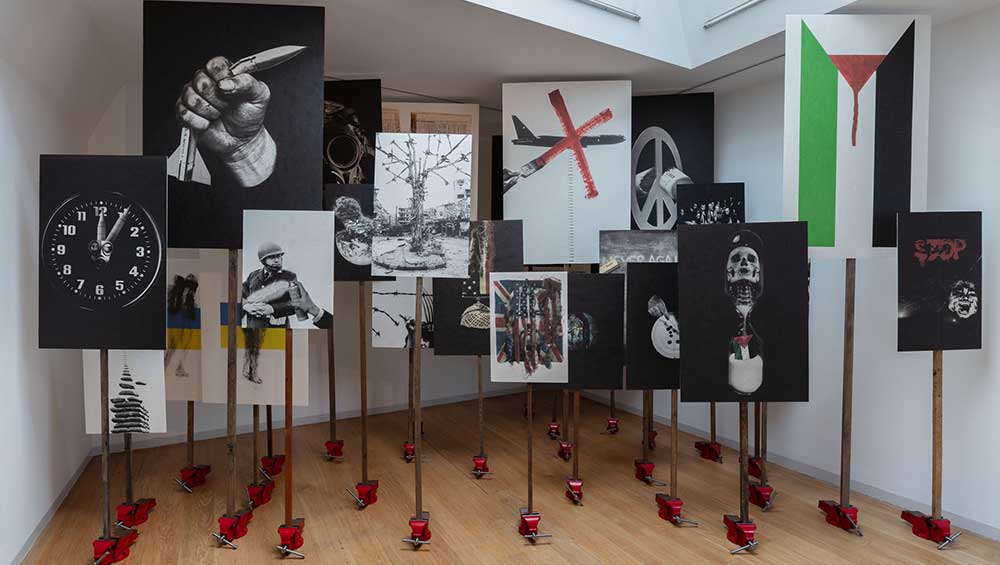
Peter Kennard: Archive of Dissent, Whitechapel Gallery, London 23 July 2024 - 19 January 2025. Photo: Lucy Dawkins.
Whitechapel Gallery, London
23 July 2024 – 19 January 2025
by BETH WILLIAMSON
Peter Kennard (b1949) has been a powerful force for resistance and dissent in political art since the 1970s. His imagery and practice have spanned a range of events and issues from the Vietnam war and the Campaign for Nuclear Disarmament to the current wars in Gaza and Ukraine, as well as the artist’s commitment to environmental activism. This new exhibition, Archive of Dissent, gathers examples of Kennard’s output from across the five decades of his career and populates three gallery spaces with this influential work.
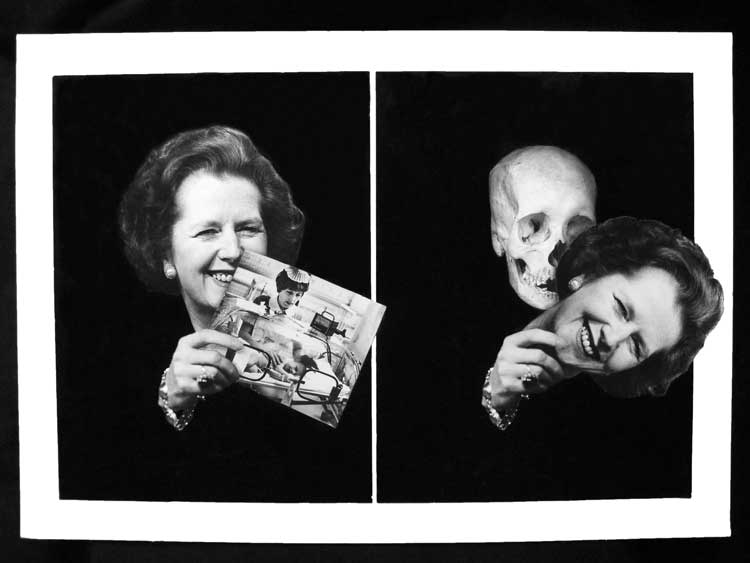
Peter Kennard. Thatcher Unmasked, 1986. Photomontage–Gelatin silver prints with ink on card. A/POLITICAL.
An atmosphere of dissent and protest permeates the exhibition from the moment you enter. How could it not? We are, after all, dealing with work by Kennard, whose photomontages were inspired by John Heartfield, a pioneer of the medium used as a political tool in the 1930s. Kennard’s montages deconstruct and reconstruct images “to show new possibilities emerging from the cracks and splinters of the old reality”.1 Shifting formats and scale allows Kennard to bring a strangeness to the familiar and the ubiquitous, a strangeness that asks the viewer to reconsider the image and what it represents. He is prising open the connections between power, capital, war and destruction of the plant. Everything is related and Kennard’s commitment to exposing those connections is patently clear: “My art erupts from outrage at the fact that the search for financial profit rules every nook and cranny of our society. Profit masks poverty, racism, war, climate catastrophe and on and on. My aim is to unmask the connection.”2
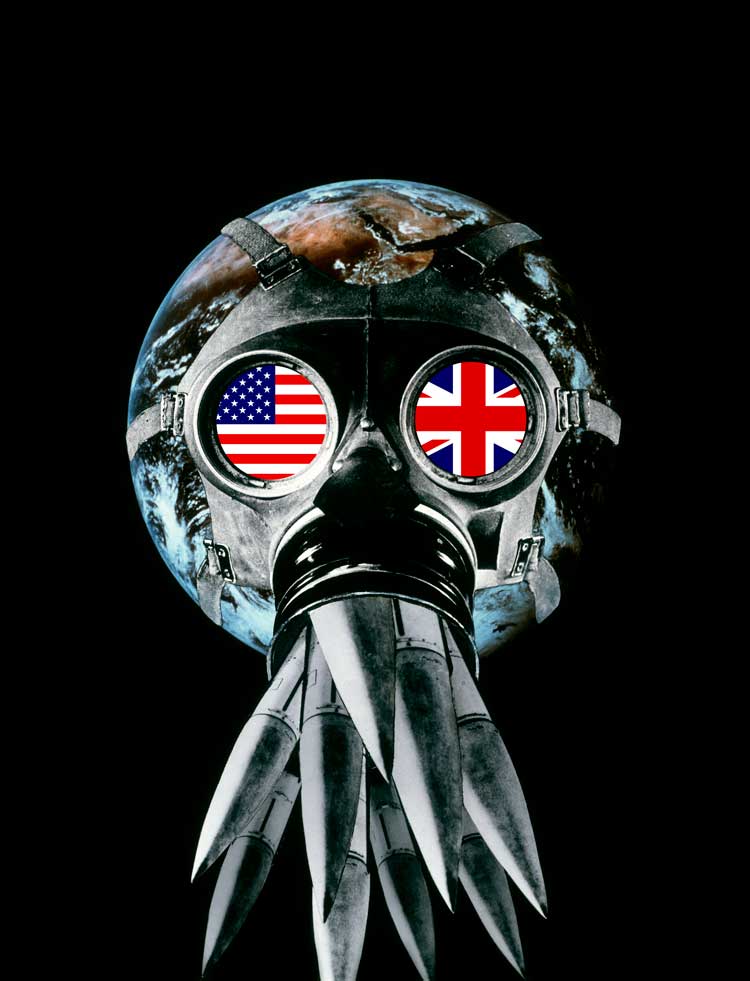
Peter Kennard. Union Mask, 2007. Screen print in colours with varnish on 300gsm Somerset Satin white paper, 83 × 66.5 cm. Courtesy the artist.
The form of this exhibition at Whitechapel Gallery is no accident. Kennard recalls the gallery space’s former use as a library and responds with earlier work and with recent installations and a pertinent new work – The People’s University of the East End (2024). Always challenging the status quo, Kennard’s work is also a repository of social and political history. A specially published free newspaper, filled with prints by Kennard, is piled high in the gallery, there for visitors to take away and ponder. A large reading table provides a space to sit and read one of Kennard’s many publications. A bank of protest posters on wooden placards are hinged to the wall and can be flipped through like a book. In another space, a group of 20 or so placards populates a corner of the gallery. Collectively titled The People’s University of the East End (2024), this is a nod to the colloquial name for the former Whitechapel Library in which the exhibition is located. With a focus on learning, community and activism in public spaces, this is work also represents something of a reprise for the artist’s protest iconography over the years.
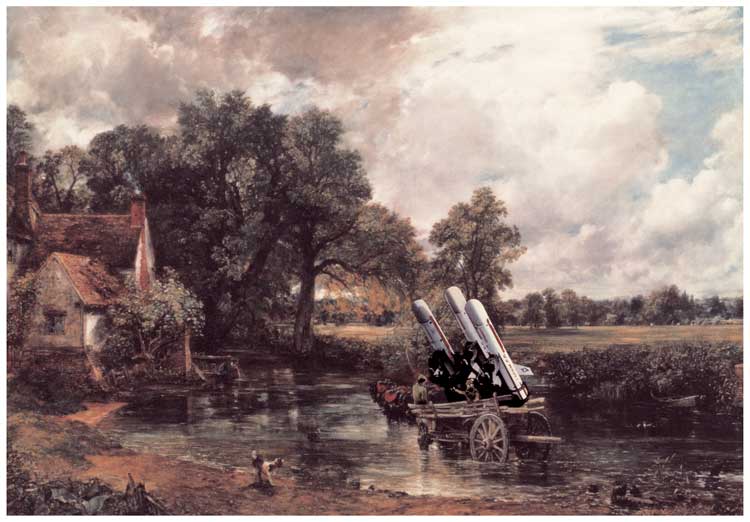
Peter Kennard. Haywain with Cruise Missiles, 1980. Chromolithograph on paper and photographs on paper, 26 × 37.5 cm. Tate: Purchased from the artist 2007. © Peter Kennard.
In a third gallery space, Kennard presents works in which he uses photomontage in a variety of different ways from the 1970s to the present day, not only deconstructing the image but deconstructing the medium itself. Forty photomontage works from 1973 to 2018 (but mainly from the 1970s and 1980s) address questions of international conflict, human rights, government cuts, the threat of nuclear war and climate change. These follow Kennard’s interest in the photomontage work of Heartfield and Hannah Höch, as well as the writings of Walter Benjamin and Bertolt Brecht. The other largescale works in this room press the limits of the medium to take it into new realms.
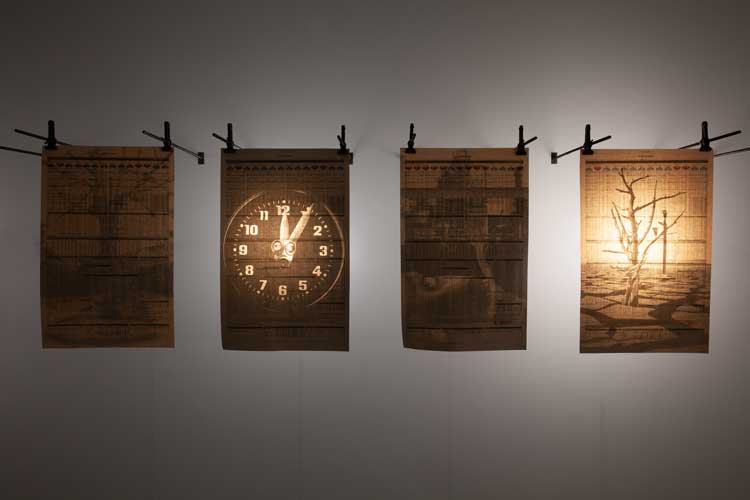
Peter Kennard and Nigel Brown. Double Exposure, 2023. Financial Times newspaper, pigment prints, metal, LED lights and Raspberry Pi. Image courtesy of the artist.
Double Exposure (2023) illuminates pigment prints made on sheets from the Financial Times, using LED lights and Raspberry Pi to control them. In this ethereal installation, ghostly renditions of Kennard’s iconic protest images appear and disappear as lights switch on and off. Hung on simple wooden supports, the images are connected by the support and the electrical wiring that runs between them to power the lighting. In a similar vein, but perhaps more disturbing, is Boardroom (2023). A series of blurred and anonymous faces are fixed to sections of salvaged boards while the logos of well-known oil and arms companies are projected on to them. Deconstructing the technique of photomontage from its original methods, Kennard also hinges and unhinges meaning as corporate power is brough to bear on people’s lives. Similarly, World Markets (1997-2024) shows the ghostly faces of men, women and children of all ages imprinted on the market pages of the newspaper. The anonymous people depicted are oblivious to the effects the markets have on their lives. In the centre of the room, a set of four library lecterns form Reading Room (1997-2024), a work in which Kennard displays newspapers in which his photomontages first appeared. These were commissioned to accompany articles, acting as what he called a “visual journalist” and responding to events as they happened. Further, this installation also gestures to the former life of the space as a library and the power of reading and learning in public spaces.
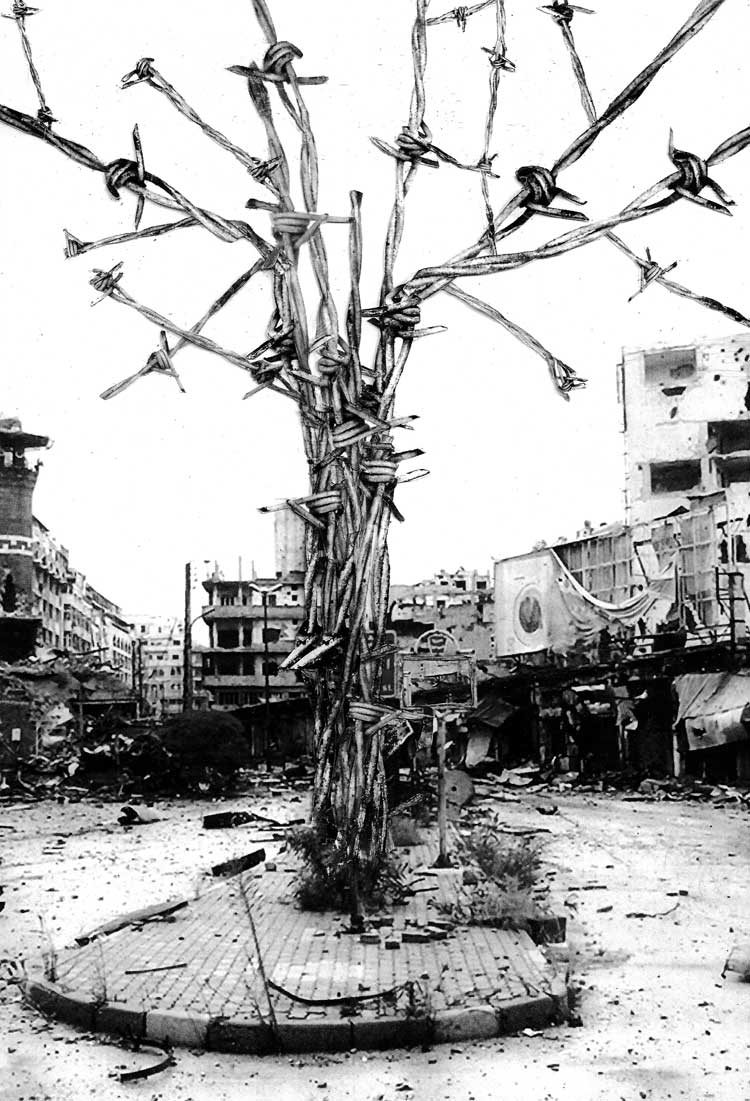
Peter Kennard. Syria, 2018. Photomontage–Pigment print, graphite, pastel and gouache on card, 55 × 39.5 cm. Courtesy of the artist and Richard Saltoun Gallery, London, Rome and
New York.
Leaving Archive of Dissent, you can’t help wondering if anything has changed, if Kennard’s activism in art over the last five decades has made a difference. Well, Kennard is still angry, but that anger is well expressed and his commitment to expressing it has never waned. His focus remains “the victims, the resistance, the human communality saying no to corporate and state power”.3 In its time as a library, Whitechapel was a space of teaching and learning. As Kennard notes, it was also a sanctuary from poverty and a place of organisation and dissent. Archive of Dissent follows in that tradition, a reminder of the need for dissident ideas, of the need for perpetual questioning of the status quo and the scrutiny of corporate and state power that repeatedly fails to put people and communities first.
References
1. Peter Kennard quoted in exhibition press release.
2. Kennard quoted in free exhibition newspaper.
3. Ibid.